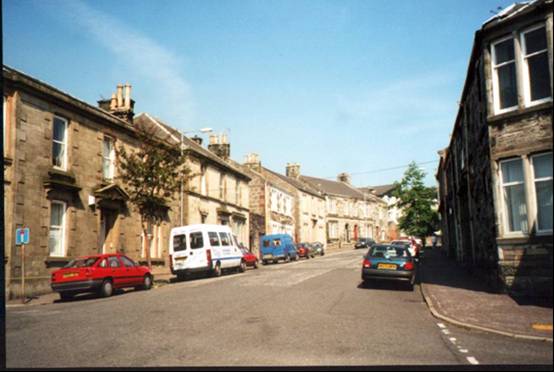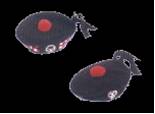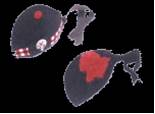|
LOCATION
Lying in the north-eastern reaches of Ayrshire,
Stewarton is 6 miles north of Kilmarnock,
some 8 miles from Irvine and the Clyde
Coast, and 18 miles south west of Glasgow.
Glasgow International Airport,
and Prestwick Airport, are short drives
from Stewarton at 15 miles, and 10 miles distant, respectively. Once a busy crossroads-thoroughfare, the town is now largely
bypassed by the main volume of north / south traffic but nevertheless, enjoys reasonable links to the main roads-network,
with the nearby M77 only minutes away.
Stewarton is also well-served by public
transport: a frequent railway service operates to and from Kilmamock and Glasgow, whilst Kilmamock and Irvine
are also served by frequent buses from Stewarton; additionally, a small bus covers the local town-area with the 'Wee Buzzer'
service.
This is a picture of a street in Stewarton
- Grahams Terrace

THE POPULAR BELIEF IS THAT THE TOWN-NAME,
'STEWARTON', IS DERIVED FROM THE HIGH STEWARD OF SCOTLAND; 'STEWARD' SUBSEQUENTLY BECAME 'STEWART' - WHICH
GAVE THE ROYAL FAMILY ITS DISTINGUISHED NAME.
Recorded existence of the town dates back
to, at least, the 12th. century, when it was ruled over by some of William the Conqueror's Norman nobles, including members
of the de Morville family, who were granted lands which included Langshaw, or Lainshaw, Estate. Another Norman, Godfrey de
Ross, was ensconced in Ruenscrige Castle, later to be known as Ravenscraig Castle, the scant ruins of which (now known as
Corsehill Castle) still stand in a field off the Stewarton-to-Dunlop road. Malcolm Canmore, who killed Macbeth and eventually
(in 1058) became King Malcolm III, also had a somewhat tenuous connection with Stewarton: it is reputed that, when on the
run before Macbeth, Canmore's life was saved by a Stewarton farmer, named Cunninghame, who hid Malcolm under forked hay; upon
kingship, Malcolm III gifted the farmer the Stewarton-located Corsehill Estate. Thus, allegedly, arose the origin of the Cunninghame
coat of arms which depicts an image of a hay-fork - by way of a letter 'Y' - and the motto, "Over, Fork Over". Others presiding
over the local estates, through the years, were the Fitzalans, the Montgomery family, the Earl of Douglas, the Cunninghames
of Robertland, the Arnots of Lochrig (presently, Lochridge), the Cunninghames of Lainshaw, and the Cunninghames of Cunninghamhead.
In the early- 15th. century, a fued arose between the Montgomeries, and the Cunninghames of Cunninghamhead; it was to last,
on-and-off, for a hundred years culminating, on 15th. April 1586, in the murder of the 4th. Earl of Eglintoun, at Annick
Bridge. Stewarton might not warrant mention in many history books, but it certainly
has a fascinating past involving the age-old lust for power and greed, with attendant nefarious schemes, battles, and murders.
However, that was in the past....
'The Bonnet Toun'
Even today, despite a decline in the town's
industrial element, Stewarton is widely known as 'The Bonnet Toun' because of its bonnet-making industry which dates back
to the 16th. century.

'Balmoral' - Knitted in top quality
Saxony
yarns, they are supplied to Scottish
Regiments, Pipe Bands, and to all who
wear the kilt. Successor to the original
'Kilmarnock Bonnet'.
Originally, from cottage-based
workshops in homes of the townsfolk, hand-knitted woolen bonnets were sold mainly at three local fairs per year: in January,
May, and October; but this was no unsupervised hotchpotch, as production and marketing control was effected by the parochial
Bonnet Court of Corsehill. However, although hitherto much slower, the inevitable 'march of progress' was to broaden the local
trade into a burgeoning national industry when, on 12th. April 1650, 'The GreatAgreement' was signed: this was a contract
between, on the one hand, Sir Alexander Cunninghame, Laird of Corsehill and Deacon Heritable of the Bonnet Court of Corsehill
and, on the other hand, one Gavin Naismith, deacon of the Incorporation of Bonnetmakers and Dyers of Glasgow; as a result,
the Laird of Corsehill gnaranteed a sufficiency of Stewarton bonnets for sale in the Glasgow markets.

'Glengarry' - Manufacture requires some
fourteen
mostly-handwork processes, and is completed
with a hand-made silk rosette; the diced
version
is considered to be, perhaps, the aristocrat
of
all bonnets.
The now-guaranteed quantity of bonnets,
for Glasgow,
had also to meet stringent quality criteria in respect of, for example, dye-colour and weight of wool used. 'Sighters', or
inspectors, were employed - in the city, as well as rurally - to ensure compliance with the new rules: any failed products
were burned! A measure of the labor-intensity of bonnet- making may be gleaned from the fact that, at this stage in the industry's
progression, all the bonnets were still hand-knitted, or 'peekied'; the needles were supported on a leather belt worn by each
knitter. During the Industrial Revolution period, numerous factories were built on the banks of the River Annick; the process
of hand-knitting now became mechanized. The first factory, known as Robertland Mill, was established by Robert Sim, in 1820;
it remained in productive existence until 1987.
Bonnet Guild Festival
A local tradition, which began in 1933, is the annual week-long Bonnet Guild
Festival, in June, culminating in the crowning of the Corsehill Queen. The Bonnet Guild was named after the ancient Bonnet
Court of Corsehill, in reverence to the town's one-time main industry of bonnet-making; membership is of around 45 local men,
and monthly meetings are held throughout the year. From a 3-days Festival, in 1933, the event now lasts 8 days.
In Festival week, each year, a Deacon and two Bailies are installed by a former
Corsehill Queen who, in the following year, crowns the new Queen. The Guild organises a full week of events and activities
for the Festival, with the crowning of the Queen (chosen from Stewarton Academy pupils) on the Saturday - the Gala Day - when
Avenue Square is bedecked with bunting, a special carpeted crowning-dias is erected against the Library wall, and folk (including
local dignitaries) gather to join in the ceremony.
The Kirkyard was Stewarton's only burial ground until the present cemetery
was opened at the start of this century. However, there were those who wanted to be laid beside their "ain folks" and burials
still took place until early 1920s, latterly only by permission of the Secretary of State for Scotland.
A look-out post, which was restored by William Smith, existed at one corner
of the yard. This was where relatives of the recently-deceased kept watch over the graves to prevent body-snatching.
In the 19th century and before, the Kirk Session acted as a kind of court dealing
with cases of fraud and other misdemeanors. They handled complaints connected with the sale of animals when usually the buyer
accused the seller of selling him an animal which was "unsound."
The main function of the Kirk Session seems to have been in dealing with cases
of fornication and there were several "compearances" each month. Married couples who appeared before the Session were accused
of "antenuptial fornication." Single girls or ladies were also compeered and charged with fornication and it was made the
custom for the females to name "the father of the child," who was then compeered at the next meeting. Most times the man named
admitted guilt but there were cases when the bounder "compeered not" meaning he had refused the invitation to the meeting
or he had hit the trail out of town.
Most of the "culprits" were admonished but others had to appear before either
the minister, the Presbytery at Irvine, or before the congregation on a Sunday
morning in the Kirk where they rebuked publicly. Fines were sometimes imposed and some had to pay two shillings to the Session
Clerk and one shilling to the Kirk Officer.
In 1825, the Session decided that members of the congregation who did not wish
to witness "this painful part of ministerial duty" should be allowed to retire "in orderly manner."
One long-serving minister who supervised the Kirk Session from 1825 until the
late 1850s, the Rev. Charles B. Steven. was himself "compeered" in connection with his involvement with several women in the
town. Local rumor was that Mr Steven was not all that he ought to be and what he professed to be and his "fornication" with
a Mrs Dunlop and others led to his downfall.
On one occasion when Mrs
Dunlop had agreed to meet the minister at the water planting?, a trap was set by her husband and two friends who pounced on
the couple
when they were in a very indelicate position. Mr Steven cried and pleaded for
mercy before agreeing to pay Dunlop £80 and his chums £5 each to keep their mouths shut.
Years later Steven's case came before the Presbytery in Kilmarnock
who neither found him guilty or not guilty as the business was conducted behind closed doors. The canting cleric agreed to
resign provided he was paid £100 a year for life. In 1859 he left Stewarton in disgrace and went to live in Paisley,
an outcast from society.
While the Parish Church
was never involved with some of the dramatic episodes and stramashes of other local churches, in 1843 seven elders resigned
en masse for no apparent reason, except that they wanted to disclaim all further connection with the Established Church.
Here is an idea of how many we are back in Scotland:
http://www.ancestralscotland.com
You searched for : picken
16 Results found
Page 1 of 2 1 2 >>
Rank order of Counties, based on the percentage of the population of each with
the selected surname.
Surname County/Town Total Occurrences
Click below for tourism information
PICKEN Buteshire
8 Ayrshire and ArranPICKEN Argyllshire
8 Ayrshire and ArranPICKEN Ayrshire
166 Ayrshire and ArranPICKEN Kirkcudbrightshire
5 Dumfries and GallowayPICKEN Wigtownshire
9 Dumfries and GallowayPICKEN Angus
4 Angus and DundeePICKEN Ross & Cromarty
1 Highlands of ScotlandPICKEN Dunbartonshire
7 Argyll, the Isles, Loch Lomond, Stirling
and the TrossachsPICKEN Renfrewshire
125 Greater Glasgow and Clyde ValleyPICKEN Argyllshire
3 Argyll, the Isles, Loch Lomond, Stirling
and the Trossachs
The data used as the basis for the place name and surname searches has been
generated by Origins.net from 1881 Scottish Census data provided by the Genealogical Society of Utah (GSU) and captured from
the original census returns. The permission of the GSU and the General Register Office for Scotland (GROS) to use this data
is gratefully acknowledged. The data is made available for personal use only, and may not be copied, distributed, sold or
published in any form without
We start here, in Stewarton, this journey will end up taking you through Canada,
Germany, England, Ireland, U.S.A. and the Dominican Republic, these being countries that have something to do with our Picken
gang in one way or another. Enjoy the reading!
|


